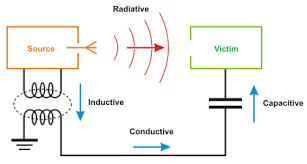Capacitor Parasitics - Designing for EMI
During your PCB
design, an important thing to consider is placement of decoupling capacitors on
your PCB for EMI. Capacitors do many things. They filter voltage droops, they
present a 'brick wall' for transients, and they try their best to kill any EMI
noise on your power rails.
One of the most common
functions though, is this filtering of EMI noise going into and coming out of
the chip on your PCB design. It's supposed to be attached as close as possible
to the input power pin of your part with the shortest, fattest trace possible,
but surely you're already aware of this (it's also supposed to have the
shortest current loop possible between the chip and part, but that's beyond the
scope of this article).
For the sake of
explanation, you can think of a capacitor as really a capacitor in line with an
inductor. Crazy? Yes it is, but it's also unavoidable. If you found a wire
lying on the ground and pick it up, it is inherently an inductor of some value
whether you like it or not. If you take that wire and cut it in half, it's
inductance value is now half of what it used to be. And, if you take that wire,
and cut it down until it's size is right about the same length of your
capacitor, the value will be roughly equal to that little hidden inductor
inside that capacitor. For anyone that has been through their 2nd semester of
'Electronics-101', they will recognize this inductor-capacitor combo as a tuned
circuit that is resonant at some frequency. The exact formula is 1 over 2-pie,
times the square root of inductance times capacitance (f = 1 / 2 p v LC).
For most low speed
applications, this isn't important. But when your trying to pass an EMI FCC
radiated emissions test, these things become critical. Especially after you
just failed the last EMI test and are scratching your head back at your desk,
wondering how in the world you'll solve this EMI problem on your PCB design.
Your even probably thinking "Hey, that frequency isn't even on this board.
Where it is coming from?".
If you take the
formula I gave you, plugged in the inductance value of the capacitor into that
formula, you'll come up with a number that incidentally, is the ideal value, in
hertz, that the capacitor will most effectively work. For example, if you take
a standard 0.1uF - 0603 capacitor, with it's normal parasitic inductance of
0.5nH, it's resonance is right at about 22MHz. And because the
capacitor/inductor is configured in series (notch filter), I know it will do
it's best at killing any noise at 22MHz. But, this isn't an Ideal world.
Before you go off to
start crunching numbers and replacing caps on your PCB design, there's another
much bigger piece to the puzzle. If you're trying to kill a particular frequency,
and you've already exhausted the more preferable way to kill EMI (softening
edge rates, lowering switching currents, etc.), you will need to find the right
capacitor using not only the parasitic values of the capacitor, but by also
including the parasitic inductance value of the traces on connecting your
capacitor to your power pin, any VIAs, and most often forgotten, the actual
pins, bonding wires, and even substrate routing inside the chip itself. The
extra parasitics alone could easily account for an extra 3-7nH.
Designing in EMI
protection into your PCB can sometimes seem like a "black box" skill.
I've heard this phrase time and time again. But it doesn't have to be
difficult. With only just a little understanding, your EMI problems can be
reduced dramatically.
Happy Reading..
Ruby


Comments
Post a Comment